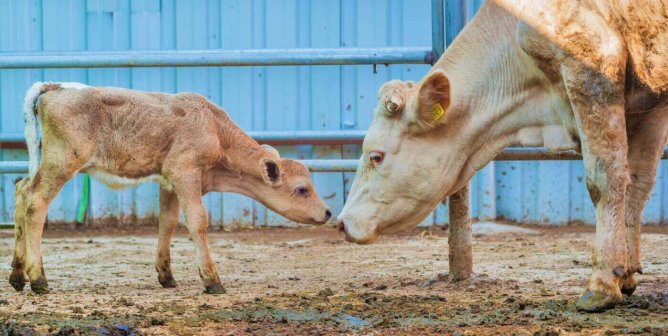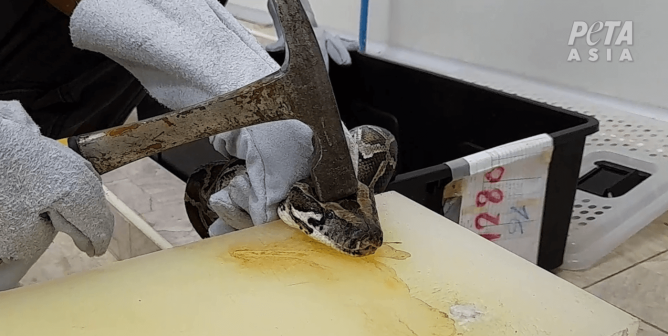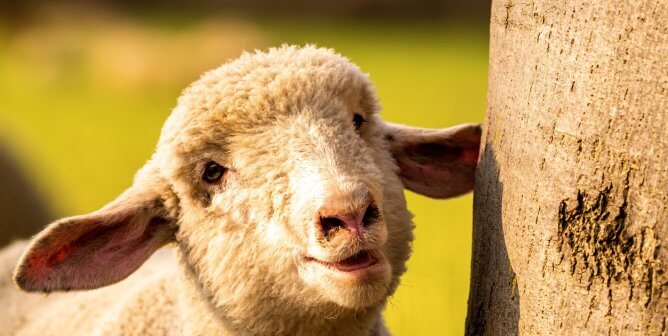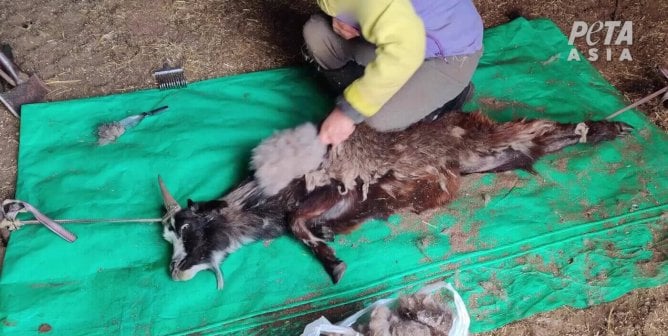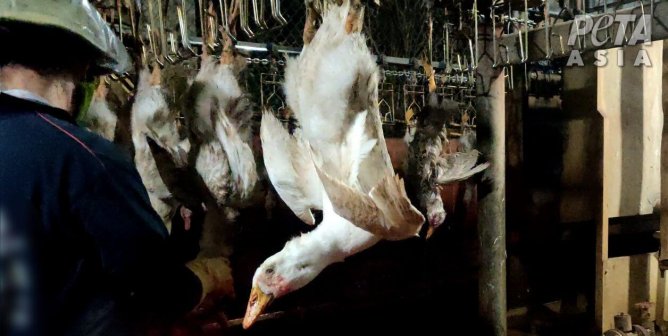Cow’s Milk: A Cruel and Unhealthy Product
Given the chance, cows nurture their young and form lifelong friendships with one another. They play games and have a wide range of emotions and personality traits. But most cows raised for the dairy industry are intensively confined, leaving them unable to fulfill their most basic desires, such as nursing their calves, even for a single day. They are treated like milk-producing machines and are genetically manipulated and may be pumped full of antibiotics and hormones in order to produce more milk. While cows suffer on these farms, humans who drink their milk increase their chances of developing heart disease, diabetes, cancer, and many other ailments.
Cows Suffer on Dairy Farms
Cows produce milk for the same reason that humans do—to nourish their young—but calves on dairy farms are taken away from their mothers when they are just 1 day old.1 They are fed milk replacers (including cattle blood) so that their mothers’ milk can be sold to humans.2
Female cows are artificially inseminated shortly after their first birthdays.3 After giving birth, they lactate for 10 months and are then inseminated again, continuing the cycle. Some spend their entire lives standing on concrete floors; others are confined to massive, crowded lots, where they are forced to live amid their own feces. A North Carolina dairy closed its doors following revelations from a whistleblower that the cows were forced to eat, walk and sleep in knee-deep waste.4 An investigation into a Pennsylvania farm that ships tons of milk for cheese production in Maryland revealed animals who were wallowing in their own manure in filthy barns with no bedding, while more than half of the cows who were being milked had leg joints that were swollen, ulcerated, or missing hair.5 Please visit PETA.org for more information on this case.
Cows have a natural lifespan of about 20 years and can produce milk for eight or nine years.6 However, the stress caused by the conditions on factory farms leads to disease, lameness, and reproductive problems that render cows worthless to the dairy industry by the time that they’re 4 or 5 years old, at which time they are sent to be slaughtered.7
On any given day, there are more than 9 million cows on U.S. dairy farms—about 12 million fewer than there were in 1950.8,9 Yet milk production has continued to increase, from 116 billion pounds of milk per year in 1950 to 215 billion pounds in 2017.10,11 Normally, these animals would produce only enough milk to meet the needs of their calves, but genetic manipulation—and, in some cases, antibiotics and hormones—is used to cause each cow to produce more than 22,000 pounds of milk each year.12 Cows are also fed unnatural, high-protein diets—which can include chicken feathers and fish—because their natural diet of grass would not provide the nutrients that they need to produce such massive amounts of milk.13
Mastitis
Painful inflammation of the mammary glands, or mastitis, is common among cows raised for their milk, and it is one of dairy farms’ most frequently cited reasons for sending cows to slaughter. There are about 150 bacteria that can cause the disease, one of which is E. coli.14Symptoms are not always visible, so milk’s somatic cell count (SCC) is checked to determine whether the milk is infected. Somatic cells include white blood cells and skin cells that are normally shed from the lining of the udder. As in humans, white blood cells—also known as “pus”—are produced as a means of combating infection. The SCC of healthy milk is below 100,000 cells per milliliter; however, the dairy industry is allowed to combine milk from all the cows in a herd in order to arrive at a “bulk tank” somatic cell count (BTSCC).15 Milk with a maximum BTSCC of 750,000 cells per milliliter can be sold.16 A BTSCC of 600,000 or more generally indicates that more than two-thirds of the cows in the herd are suffering from udder infections.17
Studies have shown that providing cows with cleaner housing, more space, and better diets, bedding, and care lowers their milk’s SCC as well as their incidence of mastitis.18 A Danish study of cows subjected to automated milking systems found “acutely elevated cell counts during the first year compared with the previous year with conventional milking. The increase came suddenly and was synchronized with the onset of automatic milking.”19 Instead of improving conditions in factory farms or easing cows’ production burden, the dairy industry is exploring the use of cattle who have been genetically manipulated to be resistant to mastitis.20
The Veal Connection
If you drink milk, you’re subsidizing the veal industry. While female calves are slaughtered or kept alive to produce milk, male calves are often taken away from their mothers when they are as young as 1 day old to be chained in tiny stalls for three to 18 weeks and raised for veal.21,22 Calves raised for veal are fed a milk substitute that is designed to make them gain at 2 to 3 pounds per day, and their diet is purposely low in iron so that their flesh stays pale as a result of anemia.23,24 In addition to suffering from diarrhea, pneumonia, and lameness, calves raised for veal are terrified and desperate for their mothers.
Environmental Destruction
Large dairy farms have an enormously detrimental effect on the environment. In California, America’s top milk-producing state, manure from dairy farms has poisoned hundreds of square miles of groundwater, rivers, and streams.25 Each of the more than 1 million cows on the state’s dairy farms excretes 18 gallons of manure daily.26,27 Overall, factory-farmed animals, including those on dairy farms, produce 1.65 billion tons of manure each year, much of which ends up in waterways and drinking water.28 The Environmental Protection Agency reports that agricultural runoff is a major cause of polluted lakes, streams, and rivers.29 The dairy industry is the primary source of smog-forming pollutants in California; a single cow emits more of these harmful gasses than a car does.30
Two-thirds of all agricultural land in the U.S. is used to raise animals for food or to grow grain to feed them.31 Each cow raised by the dairy industry consumes as much as 50 gallons of water per day.32
Human Bodies Fight Cow’s Milk
Besides humans (and companion animals who are fed by humans), no species drinks milk beyond infancy or drinks the milk of another species. Cow’s milk is suited to the nutritional needs of calves, who have four stomachs and gain hundreds of pounds in a matter of months, sometimes weighing more than 1,000 pounds before they are 2 years old.33
Cow’s milk is one of the primary causes of food allergies among children.34 Most people begin to produce less lactase, the enzyme that helps with the digestion of milk, when they are as young as 2 years old. This reduction can lead to lactose intolerance.35 Millions of Americans are lactose intolerant, and an estimated 95 percent of Asian-Americans and 80 percent of Native- and African-Americans suffer from the condition, which can cause bloating, gas, cramps, vomiting, headaches, rashes, and asthma.36 A U.K. study showed that people who suffered from irregular heartbeats, asthma, headaches, fatigue, and digestive problems “showed marked and often complete improvements in their health after cutting milk from their diets.”37
Calcium and Protein Myths
Although American women consume tremendous amounts of calcium, their rates of osteoporosis are among the highest in the world.38,39 Medical studies indicate that rather than preventing the disease, milk may actually increase women’s risk of getting osteoporosis. A Harvard Nurses’ Study of more than 77,000 women ages 34 to 59 found that those who consumed two or more glasses of milk per day had higher risks of broken hips and arms than those who drank one glass or less per day.40 T. Colin Campbell, professor of nutritional biochemistry at Cornell University, said, “The association between the intake of animal protein and fracture rates appears to be as strong as that between cigarette smoking and lung cancer.”41
Humans can get all the protein that they need from nuts, seeds, yeast, grains, beans, and other legumes. It’s very difficult not to get enough calories from protein when you eat a healthy diet; protein deficiency (also known as “kwashiorkor”) is very rare in the U.S. and is usually only a problem for people who live in famine-stricken countries.42
What You Can Do
The best way to save cows from the misery of factory farms is to stop buying milk and other dairy products. Discover the joy of soy! Fortified plant-derived milks provide calcium, vitamins, iron, zinc, and protein but do not contain any cholesterol. Soy, rice, oat, and nut milks are perfect for cereal, coffee, and soups and also work well in baked goods and other recipes. Many delicious nondairy products are available in grocery and health-food stores. Visit PETA.org for recipe ideas or to order a free vegetarian/vegan starter kit.
References
1 Katherine Wagner et al., “Effects of mother versus artificial rearing during the first 12 weeks of life on challenge responses of dairy cows,” Applied Animal Behaviour Science, 164(2015): 1-11.
2 Bovine Alliance on Management and Nutrition, “A Guide to Calf Milk Replacers,” U.S. Department of Agriculture, 2008.
3 Jeff Stevenson, “Heifers Are Still Too Old When They Calve,” Hoard’s Dairyman 15 Mar. 2011.
4 Holly Kays, “Osborne Farms Closes: Embattled Dairy Sells Off Livestock,” Smoky Mountain News 24 Sept. 2014.
5“Rights Group Accuses Dairy Farmers of Animal Cruelty _ Again,” Associated Press 28 Jun. 2019.
6 T. Dewey and J. Ng, “Bos taurus,” Animal Diversity Web 200, accessed 23 Dec. 2018.
7 Anne Karpf, “Cow longevity economics: The cost benefit of keeping the cow in the herd.” Paper presented at the Cow Longevity Conference, Hamra, Sweden, August 2013.
8U.S. Department of Agriculture, National Agriculture Statistics Service, “Cattle,” 20 Jul. 2018.
9Marin Bozic, “An Econometric Analysis of U.S. Milk Production: A Herd Dynamics Model,” University of Trento, Jan. 2009.
10 U.S. Department of Agriculture, National Agriculture Statistics Service, “Milk Production, Disposition, and Income 2017 Summary,” Apr. 2018.
11 Don P. Blaney, “The Changing Landscape of U.S. Milk Production,” Statistical Bulletin Number 978, U.S. Department of Agriculture, Jun. 2002.
12 U.S. Department of Agriculture.
13 Dr. Steven Blezinger, “Proper Protein Feeding Important to Herd Health,” Cattle Today Feb. 2008.
14 Helen Pearson, “Udder Suicide, E. Coli Kill Off Milk-Making Mammary Cells,” Nature 6 Aug. 2001.
15 S.P. Oliver, “How Milk Quality is Assessed,” Extension.org, 21 Dec. 2010.
16Ibid.
17 Richard L. Wallace, “Trouble Shooting Troublesome Somatic Cell Counts,” Illinois Livestock Trail, 15 Nov. 2000.
18 S. Waage et al., “Identification of Risk Factors for Clinical Mastitis in Dairy Heifers,” Journal of Dairy Science 81 (1998): 1275-84.
19 Morten Dam Rasmussen et al., “The Impact of Automatic Milking on Udder Health,” Proceedings of the Second International Symposium on Mastitis and Milk Quality (Vancouver: 2001).
20 Karima Galal Abdel hameed, “Genetic basis of mastitis resistance in dairy cattle – a review,” Annals of Animal Science, 4(2013): 663.
21 Susan C. Kahler, “Raising Contented Cattle Makes Welfare, Production Sense,” Journal of the American Veterinary Medical Association 218 (2001): 182-6.
22 U.S. Department of Agriculture, Food Safety and Inspection Service, “Safety of Veal, From Farm to Table,” 6 Aug. 2013.
23 “Questions,” American Veal Association, 2016.
24 American Veterinary Medical Association, “Literature Review on the Welfare Implications of the Veal Calf Husbandry,” 13 Oct. 2008.
25Jackie Want et al., “Farm Communities Face Contaminated Water from Manure, Nitrates, Records Reveal,” The Oregonian, 17 Aug. 2017.
26 California Department of Food and Agriculture, “California Dairy Statistics Annual, 2017 Data,” 11 Aug. 2009.
27 John Burnett, “New Mexico Dairy Pollution Sparks ‘Manure War’,” National Public Radio, 8 Dec. 2009.
28 M. Jenkins and D.D. Bowman, “Viability of Pathogens in the Environment,” Pathogens in the Environment Workshop Proceedings (Kansas City, Mo.: 23-25 Feb. 2004).
29United States Environmental Protection Agency,”Nonpoint Source: Agriculture,” 18 Aug. 2017.
30 James Owen, “California Cows Fail Latest Emissions Test,” National Geographic News 16 Aug. 2005.
31 Daniel P. Bigelow and Allison Borchers et al., “Major Uses of Land in the United States, 2012,” Economic Information Bulletin No. (EIB-178), U.S. Department of Agriculture, 14 Aug. 2017.
32Craig Thomas, “Drinking Water for Dairy Cattle, Part 1,” Michigan State University Extension, 5 Apr. 2011.
33 Kris Ringwall, “BeefTalk: 2 Pounds of Average Daily Gain Equals Grass Beef,” Drovers, 8 Jun. 2012.
34Miriam Matti, “Allergy to Peanut, Milk and Shellfish the Most Common in American Kids,” Allergic Living, 21 Nov. 2018.
35 National Digestive Diseases Information Clearinghouse, “Lactose Intolerance,” National Institute of Diabetes and Digestive and Kidney Diseases, May 2014.
36“Lactose Intolerance: Information for Health Care Providers,” NIH Publication No. (05-5305B), U.S. Department of Agriculture,
Jan. 2006.
37 Severin Carrell, “Milk Causes ‘Serious Illness for 7M Britons.’ Scientists Say Undetected Lactose Intolerance Is to Blame for Chronic Fatigue, Arthritis, and Bowel Problems,” The Independent 22 June 2003.
38International Osteoporosis Foundation,”Calcium Map,” 2017.
39 Rajasree Vijayakumar and Dietrich Busselberg, “Osteoporosis: An under-recognized public health problem,” Journal of Local and Global Health Science, 24 Jan. 2016.
<sup40 D. Feskanich et al., “Milk, Dietary Calcium, and Bone Fractures in Women: A 12-Year Prospective Study,”American Journal of Public Health 87(1997): 992-97.
41 Anne Karpf, “Dairy Monsters,” The Guardian, 12 Dec. 2003.
42 U.S. National Library of Medicine, “Kwashiorkor,” Medline Plus Medical Encyclopedia, 6 Dec. 2018.
